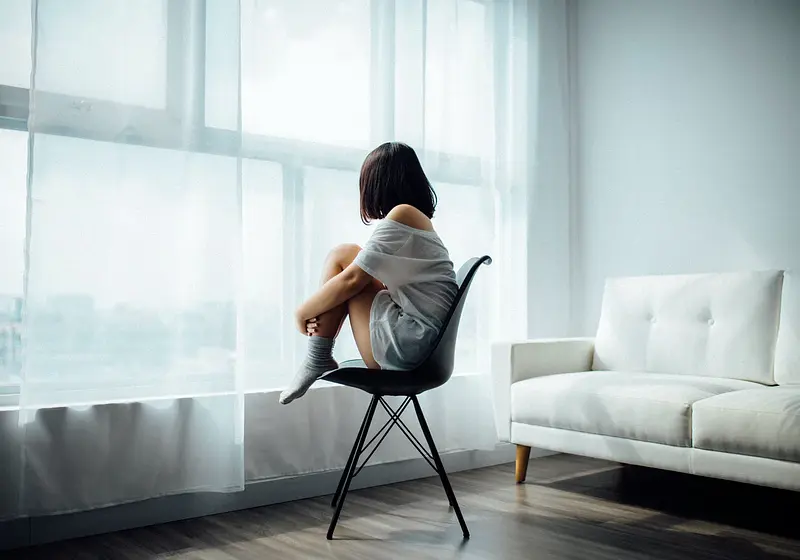Trigger warning: self-harm
They're just doing it for attention. Are they suicidal? Why are they wearing long sleeves in the summer?
Before I get into the heavy significance of National Self-injury Awareness Day (SIAD) to me, I want to acknowledge that self-mutilation is not something to be overlooked. While it varies from person to person, it can be a cyclical way of coping, and a habit that is hard to get out of. While it is incredibly hard, if you or someone you know is self-harming, please reach out to a professional to seek assistance in putting a stop to the process or reach out to the National Self Harm Crisis text line.
When March 1st came around the corner this year, I swirled a semi-colon on the inside of my wrist, where crimson slits were once haphazardly tallied, like days ticking off. When March 1st came, I was reminded of the calmness the pain seemed to bring; how the handle of a razor once steadied my shaking hand.
Self-harm is an issue that does not receive nearly enough attention and has often been classified as a taboo or sensitive topic. It is essential that we talk about mental health, that we build healthy coping mechanisms, have access to resources, and that self-injury awareness, as well as more openness around the myths that surround it, are built into the everyday conversations of our lives: not just the ones we have around this dedicated day.
Let us slide into your dms 🥰
Get notified of top trending articles like this one every week! (we won't spam you)Debunking myths around Self-Mutilation
Depiction of self-harm media is rare and often exhibits that self-mutilation has no one "motive" and can vary from person to person. While the media lacks awareness or representation of self-harm, some examples include 17-year-old cutter Charlie (from Kathleen Glasgow's moving novel Girl In Pieces), clips Ginny seen with a lighter against her skin to calm her anxiety in Netlix's Ginny and Georgia, and Sky from Thirteen Reasons Why who self-harms in order to stop herself from attempting suicide.
For talking about my own experience, I will often be referring to self-harm as "cutting", but burning, poking, marring, scratching, and repeated hitting are other methods that self-harm may take. While there are many definitions of self-harm, in my experience, it took form as an intentional process of physically damaging one's body causing external pain, in order to deal with internal pain.
This article has been one of the hardest things I've had to write. Out of my close friends and family, only a few are aware of the sliver meticulously stitched into my left arm, and many of them are unaware of the reasons why I chose to deliberately hurt myself. That's the thing the movies, shows, and books don't always get right: self-harm isn't always a choice.
The first time, it was, for me, a desperate one, a part of me itching to have the psychotic pleasure of watching my skin pucker up around the blood to form a scab. The second and third times, it's comfort, unaware numbness, and loneliness that seeks closure. But then, after a while, it became routine.
And the more I cut myself, the more I wanted to. Whenever I could feel my anxiety building, I would calm myself with the reassurance that it would all go away once I got home, behind closed doors, while my parents' voices, growing irate, blurred into the background.
I think another part of it was the thrill of never getting caught. I knew it wasn't normal for me to get such a rush off nothing but the red ocean that spilled tears onto my forearms like ink on fresh parchment. That's another thing we, as a society, need to address: that people who self-harm know what they are doing.
Oftentimes, those who engage in self-mutilation are not in the right mental state to fully comprehend the effects of what they are doing, and instead are more focused on the feeling they receive from their actions. I could never understand why cutting was such a big deal. Shaving and getting tattoos were practically socially acceptable ways of doing the same thing I was doing, but somehow, when I showed up at school with red scratched-up arms, I sent out the message that I wasn't okay.
Many of us who self-harm don't know why we do it, we just know that it takes away a portion of the hurt, and there aren't many other ways we may understand how to feel better. Often, it happens because we are left alone or because we don't know how to express the need for help, but when one is self-mutilating, we are not always able to recognize how others interpret what we may view as a way of calming ourselves down.
Self-harm is always suicidal. In my case, this was completely untrue. Self-injury may be a way to deal with internal problems.
It may be a form of self-punishment, often as a result of trauma. It could be a way to express pain or a silent plea for help. While self-harm is often linked to suicide and spiraling thoughts of depression (I will admit that in my period of self-harm, suicide and intrusive thoughts did cross my mind), Non-suicidal self-injury, or NSSI, is common as well, particularly in teens or people in a vulnerable emotional state.
The last thing that people assume about those of us who engage in a form of self-harm is that we do it for selfish purposes. Self-harm is NOT always obvious, especially if someone goes about it in a discreet way. Frankly, it is none of your business why the person is engaging in self-mutilation.
It is not your place to tell them that what they are doing is "selfish" and it is not up to you to define what a "selfish" intent is. So, instead of focusing on blaming or assuming that the motives are selfish, you can offer support. A little kindness certainly doesn't hurt, and sometimes, it means a lot.
Take the Quiz: Which Indian city is the perfect holiday spot for you!?
Let's match you with an Indian city that you would love!
Why I Can Say I'm Over a Year Clean of cutting
a post from singer Madison Beer, opening up and normalizing talk around self-harm
"You don't look like the kind of person who would cut themselves" or "You seem so happy". No one "looks like the kind of person who would cut themselves" and no one is happy 100% of the time. When I was cutting, I felt obligated to appear happier than anyone would find realistic.
I know many of the ones who know me noticed, but there was something in them that wanted to believe that I could be that happy. Somewhere inside, I wanted to believe that I could be too.
The first time I realized that my way of calming myself was mentally damaging and affecting others around me was when my middle school nurse confronted me about the scars on my arm. She mentioned that an anonymous person had noticed and was worried about me. The look on her face and the softness of her voice was what drove me to stop.
I started to open up about the things I was feeling, how I was overwhelmed and hated who I had become. When my close friends and family members learned what I was doing, I saw the effect of my pain on them. I wasn't a burden, I was valued in their lives, and I didn't see until then how my internal pain was important to them.
I started to get better at noting the steps before I would start to lose a part of myself and reach for a razor, a shard of broken glass, anything that would do the job. My school nurse told me I could come into her office whenever I felt the feeling of "losing control" or urge to hurt myself, and that she wanted to help me get better at finding other ways to cope.
Discovering alternative coping methods and talking to others about what I was going through made me start to unpack the feelings I had buried deep in my skin. While stopping the almost addictive cycle of self-harm was one of the hardest things I have done, it is one of the things I am most grateful to myself for, and I will never stop loving myself for choosing to get help.
alternative coping mechanisms
Often, the appeal of self-injury is linked to the sensation received from the procedure. The numbing sensation, for me, was what led me back to it over and over, even when I knew I should stop, or had gone a while without self-harming, and would return, feeling more disappointed and worse about myself than ever. I was drawn to the inexplicable physical pain because it distracted me from other things that were hurting me.
While different tactics work well for different people, here are the four most successful methods I continue to use in order to cope.
1) Therapy
My therapist is one of my favorite people for the way that she has helped me grow, unload, and unpack the scary crevices of my wounds. I look forward to weekly therapy, whether it's individual or group-oriented, despite the fact that it is sometimes via zoom. In Asian culture, there is a stigma around discussing mental health and receiving help, including therapy.
When my parents first discovered I was self-harming, they were uncomfortable addressing it with me and recommended therapy. I was incredibly stubborn and resisted it, going through dozens of therapists (primarily white middle-aged women) and all of them seemed to be in it only to offer a diagnosis or cut to the chase. There was already something unfamiliar about sharing so much within the first few minutes of meeting a stranger and the conversations in the sessions made me feel alienated and more like a job than a human being.
After what felt like the 100th hour of meeting new people and having them tick off concerns on their clipboards, I decided to temporarily give up on therapy. Part of me had a hard time accepting that receiving help meant that I had to understand that there was something to recover from.
If you are fortunate enough, I highly encourage you to try therapy. Finding a therapist, at least for me, is almost like going on a bunch of first dates. I know it sounds weird, but hear me out.
Through each session, you learn more about yourself and offer feedback while discovering what works for you, which may vary depending on your needs that day. After you settle on a therapist, try a few sessions, even if you are skeptical, and you may find that it has miraculous effects. Most of all, it has allowed me to feel less guilty about talking about myself and find closure in areas of my life I am still working on.
2) Journaling
Journaling at the end of the day or simply finding time to write down my thoughts has helped me work through what I am thinking, or why I might be feeling the way I do. Once I started to feel the urge to cut, I would often keep a journaling jar of good things or "milestones" when I was feeling particularly full of life or at peace with the world, myself, everything. This would make me smile and provide me with a reminder of why I keep going and why it is all worth this hard fight.
Here is a tip for those of you starting off and unsure what to write about: use a prompt, perhaps start with something you are grateful for, what you love about yourself today, a fun quote or song lyric that captures your emotions, or simply start writing and see where your hand and mind lead you. Write as little or as much as you want, but don't make journaling an obligation or it may start to feel like another chore you must complete.
Some days, I write a word and keep it at that, and others, I pour my soul out while doing a (healthy) amount of crying and sad-music listening. There are still times when I lose control and when it inevitably happens, I try my best to make sure that before I get caught up in the whirlwind, I have a pen in my hand and tell myself to write until I feel like myself again and can be assured that I won't do anything I might regret.
3) Writing on my skin
Writing on your skin, or tracing old worn-out wounds instead of re-opening them is a useful tactic, especially for cutters. Part of the appeal of cutting is to see the mark it leaves, and while writing or making a mark you might normally make with a knife or another sharp object, with a pen instead, will leave a temporary harmless mark that you can choose to wash off.
A few months after I stopped cutting, I would still feel incredibly self-conscious about the ways my arms looked, worried that people would see right through my lies that I had "fallen off a tree" or "a cat had gotten mad at me". I hated having to make excuses, and my marks wore me like a scarlet letter, giving me more unneeded body dysmorphia, which most teenagers already have well more than enough of.
Not only is writing on your skin more of an art form that can be compared to graffiti, but it allows you the same sensation. When you're first transitioning from sharper tools to writing utensils, I would recommend you start with a ball-point pen, as it has a stinging sensation that is not painful but will allow you to feel the same form of adrenaline.
After a while, try transitioning to a softer washable marker or felt-tip pen. I often write encouraging little self-love notes over my self-harm scars, and this method worked well for me because it provided an easy, unquestionable excuse for why I was writing on my arms, such as my bad doodling habits or boredom.
4) Creating time for self-care
As young people, we are familiar with the pressure of having to do everything and become everything they have set out for us to become. We are constantly catching up with our futures and comparing ourselves to strangers or people we don't know.
Learning to unplug myself from electronics and engage in a self-care activity of my choice, such as a warm bubble bath with candles, reading a book in a tree or listening to a podcast, baking karaoke, cleaning my room, meditating, exercising, or taking a calming walk outdoors has changed me entirely. I can see a huge boost in my mood, which has allowed me to feel better about myself and my body image.
Building me-time into my day, regardless of how busy or packed it may be, has benefited my well-being and allowed me to take a step back instead of overworking myself. When self-care becomes a habit, we develop more healthy relationships with ourselves, and it is important that we have something that brings us pleasure every day, and that there are things we can look forward to.
It can look like taking meditation breaks in between study sessions, turning down plans without feeling guilty in order to catch up on sleep or get a break, or even something as little as your everyday skincare routine.
Once you find something that brings you joy, create time for that, and recognize that self-care is not selfish. It should be just as much of a priority as your other obligations.
Then again, it is also important to recognize balancing taking a deep breath and doing what you enjoy with social time. For me, my self-harm episodes would occur most when I was alone because there was no one there to stop me from spiraling. Surrounding yourself with people who make you feel good, and who can support you when something triggers a memory of self-harm can be another way of caring for yourself.
An example of how being around people who love you is beneficial is when I broke a glass, saw the broken pieces, and was overcome with the urge to plunge them into my skin. Even though I was in a perfectly fine emotional state prior to this incident, if I had been on my own, I would not have had time to think before acting, but my loved one was there to get me through it.
When we normalize healthy ways of coping and self-care, we become happier versions of ourselves. I would never have imagined who I have become a year later and I would never have realized how much freer I feel by unloading some of my internal conflicts and coping with my past in order to build a different future.
What Can I do for self-Injury awareness day?
National Self-Injury Awareness Day is an opportunity to check in on the mental wellbeing of your loved ones, and a day to remember to be gentle with yourself. It's a reminder that we are all going through something that we cover up: whether it be by pulling up your sleeves to conceal your scars or simply keeping your problems to yourself. I don't want anyone to ever feel the way I did when I was self-harming, and the journey of restoration starts with yourself.
Today, I can tell you to say that some days are going to be hard, some people will make you hurt like [censored], but be kind to yourself. You deserve it. You are so beautiful and I love you.
There are so many people who adore you and who want to provide you with comfort. We'll get through this together, I promise, and someday, you'll look back on your faded scars and remember how strong you are for what you've survived.








.jpg)






